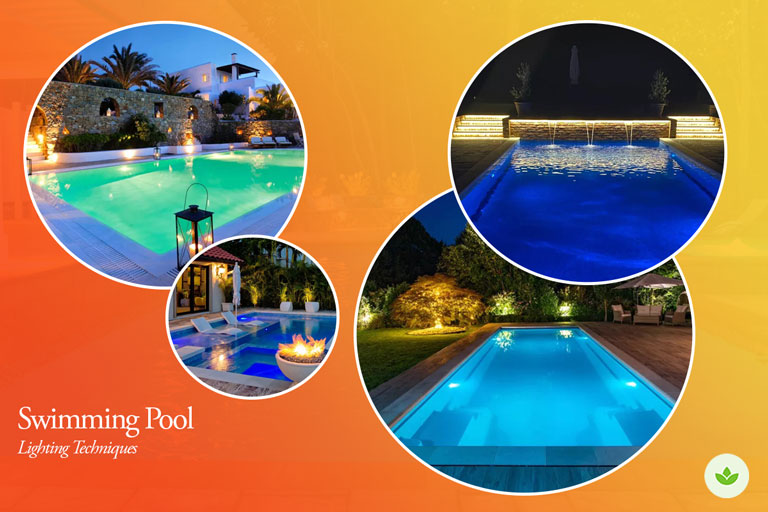Who doesn’t love a refreshing dip in the pool? But why limit the fun to daylight hours? With pool lighting, you can extend the enjoyment well after dusk. In this guide, we delve into the world of swimming pool lighting and explore various techniques to create a well-lit oasis right in your own backyard.
Pools today boast a variety of features; from stepping stones, and vanishing edges to fountains, bubblers, waterfalls, spas, and tanning shelves. Lighting should accentuate these elements that make your pool unique. Do not forget to light the surrounding hardscape and specimen plants.
Apart from adding allure to your pool, lighting also enhances safety. Since the pool is usually the main point of attraction in most backyards, you to enjoy the sight from a deck or kitchen window while creating a backdrop for entertaining guests.
But the pool lighting should blend seamlessly with the overall landscape lighting scheme. Plan ahead for the lighting as you install the pool, whether it is inground or above ground.
Disclaimer
While pool lighting can be undertaken as a DIY project, it is prudent to seek the services of a pool contractor or a licensed electrician (as may be required by code).
Check if your jurisdiction requires a permit for the pool, the lighting, or both. Some jurisdictions only allow for low-voltage (12-volt) systems, while others permit 120-volt systems provided there is proper grounding
Why light a pool
Lighting impacts both safety and aesthetic. It allows for safe navigation in and around the pool as well as improving visual appeal.
Safety:
If for no other reason, light your pool for safe nighttime safety, particularly for households with children and pets. Lighting provides a clear view of the pool’s boundary and the wet deck surface for safe navigation.
Illuminate all areas of importance. We are talking; the pool itself, steps, entries, exits, and the surrounding landscape elements. The pool deck, steps, and pathways leading to the pool should be properly lit.
Underwater pool lighting can sometimes furnish sufficient residual light on the pool deck for safe passage.
Mood & Ambiance:
In addition to safety, lighting can establish an atmosphere or ambiance.
A well-lit swimming pool offers almost as much pleasure as a view and a backdrop for entertaining guests as it does in the swimming it provides. It is usually the dominant attraction on any property.
Highlighting surrounding features such as a gazebo improves the overall appeal of the space. And with the underwater lights switched off or dimmed down, the mirror surface of the pool can reflect the surrounding landscape lighting creating a magical atmosphere.
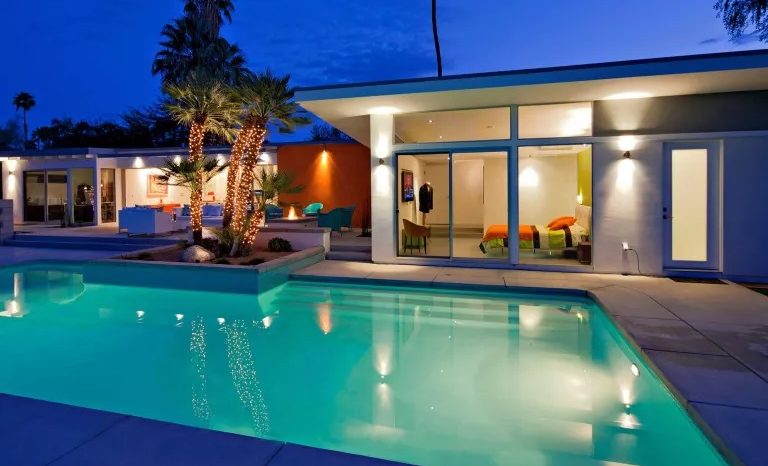
Best time to Install Pool Lighting
It is best to install lighting in conjunction with the pool construction. It is easier to plan the wiring, niche, and fixture placement then.
Installing niche lights to an existing pool usually involves a lot of core drilling for the wire run. This should be handled by a professional to avoid mishaps and can be quite costly.
Rest assured, if you are lighting an above-ground or existing in-ground pool, solutions exist. Surface-mounted fixtures that can be attached to the side of your pool using adhesive backplates, suction force, or magnetic backings. Underwater lights can also be mounted on the pool ladder without reconstructing the wall
Pool Lighting Design
A good lighting design seeks to create an even illumination throughout the pool. It should eliminate dark spots and hot spots of light. The pool lighting should integrate seamlessly with the overall lighting scheme without overpowering it.
Envision your pool, its exquisite form and contours coming to life after dark. Assess the pool’s layout, size, shape, finish, water clarity, steps, ledges, and the surrounding landscape elements.
Seek to highlight features that make your pool unique; be it a spa, tanning shelf, fountain, or grotto waterfall. Showcase changes in depth and elevation.
Lighting Techniques
There are 2 ways to illuminate a pool:
- Light the pool from within.
- Light the landscape features surrounding the pool and let the water act as a black mirror.
- Or do both.
Underwater Lighting:
Due to the nature of their construction, most pools are attractive when lit from underneath. This is done with wide-beam spread fixtures attached to a niche on the pool’s wall to create a uniform glow underwater while casting spill light on the deck.
Submersible lights accentuate interesting shapes, walls, bottom, finish material, and textures. To light pools with a relatively reflective color such as blue, green, or blue-green, use low-wattage lamps to keep the visual effect in balance. Connecting the fixtures to a separate dimmer can help maintain visual balance.
Underwater lighting is most effective if the water can be kept reasonably clear. Natural pools often have soil particles floating in the water, making them less desirable for underwater lighting. Lighting from outside the water works better for this type of pool.
The light source should be concealed from view and should not shine a distracting glare on the swimmers.
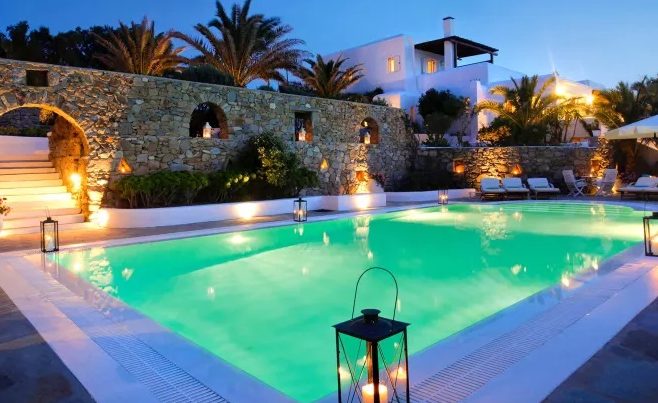
External lighting:
External lighting can be used to create a sparkle or dazzle on the surface of the black water surface. Areas surrounding the pool can be accented with light to add interest and increase illumination. As a result, the interior and exterior lighting blend to provide a safe level of illumination at the pool deck.
Some popular techniques used include
- Downlighting from nearby trees casts functional light on the pool deck for navigation while highlighting the differentiation between the deck and the pool water. Any overhead lights should be placed so as not to cause glare to the viewers and swimmers.
- Uplighting the pool perimeter, surrounding wall, foliage, or large specimen trees near a swimming pool.
- Mirror lighting: A darkened pool surface can beautifully reflect the well-lit architectural facade, nearby structures, topiary, and specimen trees. Japanese lanterns, tiki torches, and firepits around the pool can create mesmerizing reflections.
Fixture Selection
With advancements in lighting technology, lighting options have expanded. From wet niche luminaires to nicheless and floating lights, you have an array of options to suit your pool’s unique features.
Niche Vs Surface mounted lights
There are two main categories of underwater pool lights: wired and surface-mounted (nicheless) lights.
- Surface-mounted lights are not the best long-term solution but work well for above-ground pools. If your pool was not built with provisions for a niche, surface-mounted lights provide a convenient alternative. But these lights, especially the battery-powered ones, are not as bright as their hard-wired counterparts.
- Wired, flush-mounted pool niche lights are installed into the pool’s shell during construction. A hole is cut in the sidewall of the pool to accommodate the niche. A niche is essentially a container, made of plastic or stainless steel that holds the lighting fixture. The container also includes a cutout to accommodate the wiring and the wire runs through a conduit within the pool shell before going underground to connect to the power source and controller.
Water intrusion:
Submersible lights should be watertight and UL-tested for leakage. Even lights placed near the edges of the pool are susceptible to moisture damage as the pool water tends to splash and find its way into the lighting system.
An IP68 rating provides maximum intrusion against water intrusion to protect the lamp, socket, and other internal components.
Materials & finishes:
Choose corrosion, rust, and UV-resistant plastic materials, aluminum alloy, brass, or stainless steel.
The fixture’s finish should blend seamlessly with the pool. Many fixtures are finished in polished chrome and fasteners for the fixtures are usually stainless steel.
Lamp type:
There are three common types of bulbs used; incandescent, LED, and fiber optic.
- Incandescent lamps: Incandescent and halogen lamps have largely been phased out for LEDs but can be found in older pools
- LEDs: Although LED lamps command a higher initial investment, they offer exceptional energy saving, are robust, long-lasting, and produce a variety of color temperatures. Most LED lamps operate at 12 to 15 volts and require a transformer to step down the voltage from ~120 volts in the US (220 volts in many countries) to 12 to 24 volts. Working with a low-voltage lighting system outdoors is safer and eliminates electric hazards.
- Fiber optic lighting: Fiber-optic systems are the most expensive and intricate to install and have largely lost market share due to the widespread adoption of LEDs. They are commonly employed in higher-end pools to achieve special effects like twinkle effects.
Kelvin Temperature:
Kelvin temperature describes the color (coolness or warmness) of the light. Most lighting practitioners recommend a soft white light (2700 to 3000K) that creates a soft colored glow depending on the wall and floor color.
Although most pools are not lit with vibrant Vegas colors, consider using RGB or the higher quality RGBW color-changing LED fixtures. With a computerized color wheel, the color can be set for special events and holidays o programmed to create fun dynamic lighting effects or sequences of colors. Any colored effect should be done without overwhelming the surrounding.
Beam Angle:
Beam angle or beam spread is the angle from which light is produced from a source ranging from narrow spots to very wide flood or wash lights. Use underwater lights with a wide beam spread (>60º) to provide an even wide gentle wash of light.
Opt for fixtures with frosted glass lenses. These lenses make the light produced much softer and prevent that nasty glare.
Control options:
Simple on/off switches, timers, a photocell, dimmers, and color-changing capabilities offer the ultimate control over the lights.
Divide your lighting into zones, allowing for adjustment of brightness and timing separately for each. With remote and smart control, you can set the mood with color, intensity, and patterns with a simple press of a button or using an app.
In fact, a dimmer should be installed with pool lighting. A dim glow of light is all that is required to identify the pool’s edge. Dim the lights for a soft cocktail hour or late evening swim, and use full brilliance when children are in the pool.
How many underwater lights?
The number of lights depends on the pool’s shape, size, wall, and floor color.
One light is adequate for a small pool up to 15 feet long. Pools longer than 20 feet will require two lights or more for even larger pools. Pools with lighter finishes require fewer interior lights while darker finishes may need more lights.
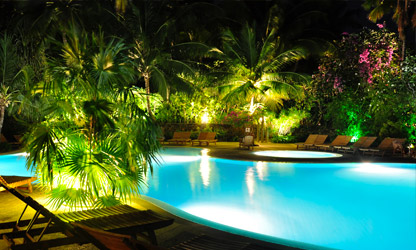
Pool Light Installation
Fixture placement
For smaller and average-sized pools, a common approach is to position the light at the deep end, facing away from the residence and main viewing points. Where more lights are required they are mounted in one of the side walls facing away from the main vantage points. The fixtures are mounted 6 to 18 inches below the water level.
- For rectangular pools, space underwater lights about 8 feet apart along the wall.
- For irregular, L-shaped, and smaller freeform or partitioned pools, treat each section as a separate space. A single fixture should be enough for each. Be sure to match the brightness and beam of the lamp with the size of the space or feature being lit.
- In curved pools, consider the shape of the wall and the light’s direction. Aim for even illumination without harsh shadows or hot spots of bright light.
- Ledges & Swim-outs: Position the lights opposite the ledge area. Use smaller compact lights to illuminate steps in the pool. In larger pools with steps on the narrow edge, install lights on the length closest to the house.
- Other pool features: For water features like waterfalls and vanishing edges, aim to catch the water as it falls to the pond or catch basin. Use a submersible to uplight a tumbling fall. For a narrow sheet of water, such as would be the case for many vanishing edge pools, install diffuse strip lights beneath the ledge to catch the water as it drops off the edge. In spas, ensure even illumination of the entire spa area, away from seating positions and footwells.
Number of Lights = Pool Surface Area x 8 Lumens / Lumen Output of Each Light. Installation Depth: For wet use, these lights are suitable for both in-wall and on-floor applications (without a guard). When submerged, the lens top should be a minimum of 4 inches below the water level. Position lights to highlight desired features while hiding the direct light source from view. Closer light placement prevents shadows and dark spots, avoiding excessive spacing. Care should be taken when placing lights near walls to prevent glare. Consider surface finishes; lighter finishes reflect light better, requiring fewer lights, while darker surfaces may need more lights. For irregular pools, multiple smaller lights can ensure uniform lighting. Indirectly illuminate steps by projecting light from adjacent walls onto the steps. Sidewall fixtures can highlight pool walls and floors, accentuating water body shape or material color and texture. For instance, in swimming pools, fixtures must be at least 18 inches below the water’s surface, except for those labeled for a minimum depth of 4 inches. In decorative pools, fixture lenses must be submerged, with a reasonable minimum of 2 inches below the low water level.
Wiring
In the majority of cases, installing an inground pool light does not necessitate draining the pool.
Begin by finding or creating a dry area away from the pool to place your power supply or transformer. Install the power supply between the GFCI outlet and the pool’s junction box. The power supply should be in a weatherproof container. Grounding the transformer and installing a ground fault circuit interrupter (GFCI) is required for any moisture-involved installation. The GFCI outlet cuts out the power in the event of a short circuit.
The junction box should be located a minimum of 4 feet from the pool’s perimeter and possible splashing and 8 inches above the pool’s water level. It could be located against a wall or fence.
Use waterproof connectors and ensure proper wire sizing and installation with no exposed wires.
When the light fixture is placed in the niche, the cord should be coiled carefully about the rear portion of the niche. The fixture is then firmly secured to the niche.
Maintenance Tips:
Exposure to harsh chemicals like chlorine and salt water can lead to the deterioration of underwater light fixtures over time. Water also wicks into the fixture, and niche possibly causing damage and wear to the cabling.
- Inspections: Periodically inspect your pool lights for any signs of damage, cracks, wear, corrosion, or water intrusion. Inspect the electrical connections to ensure they are secure and free from corrosion.
- Regular Cleaning: Cleaning removes debris, dirt, and algae buildup. Use a soft cloth or brush along with a mild cleaning solution to gently scrub the light fixtures.
- Bulb Replacement: Bulbs may have a recommended lifespan or usage hours before reaching a point of damage and requiring replacement. If a bulb is not functioning or has significantly diminished brightness, replace it with a new one of the correct type and specifications. Most outdoor pools provide wet niche lighting with sufficient cord to allow the unit to be brought out of the water for lamp replacement. It is essential to turn off all power during the installation.
- Seal Maintenance: Regularly check the seals and gaskets around the light fixtures to ensure they remain watertight. Replace any worn-out gaskets to prevent water leakage.
A qualified pool technician can perform comprehensive inspections, cleanings, and maintenance tasks to ensure optimal performance and safety.
Pool Lighting Ideas
Water features:
If your pool includes a water feature like a fountain, develop a lighting strategy to enhance its visual appeal. Lighting the agitated water from underneath a waterfall creates a soft wash of light from the edge of the fall’s precipice while highlighting the movement.
Ensure these features are appropriately illuminated without overpowering the pool lighting.
Illuminate the surrounding:
Beyond just illuminating your pool, creating a captivating visual harmony in the surrounding areas is equally vital. Whether it’s accentuating the beauty of trees and plants or adding a touch of magic to flower beds with low-voltage fixtures nestled among the mulch, the possibilities are endless.
- Highlight pathways leading to and around your pool for safe navigation.
- Illuminate the lush plants, trees, and shrubs surrounding the pool to create a stunning natural backdrop.
- Pool decks should not be overlooked when it comes to lighting.
- And let’s not forget the structures surrounding your pool, such as outdoor kitchens. Subtle recessed lighting and strategic uplights can both enhance their appeal and functionality.
As your landscape evolves, tailor the lighting to fit the changes.
Japanese lanterns:
Infuse romance into your pool area by dotting lanterns around the pool. Oversized lanterns filled with candles, whether real or LED, create a romantic and fairytale-like ambiance that is hard to resist.
By combining the light from the lanterns with warm-hued uplights and classic underwater pool lights, the entire setup comes alive in the dark.
Moonlighting:
You can simulate the moon’s effect by mounting light fixtures that produce a soft, wider beam spread of light up high on a tree, aiming them down towards. This creates beautiful moonlighting effects for your pathways, pool deck, and surroundings.
Lights mounted above the secondary canopy can produce dancing lights with shadows of branches and leaves that sway with the wind
String lighting:
String lights, festoon lights, or bistro lights are perfect for creating a festive atmosphere. Hang them around your pool area to set a warm mood with their warm glow. They can also provide functional light over the pool. You can also use them to light up the nearby trees or a pergola.
Fire & Tiki torches:
Gas lights or oil-filled tiki torches are used to illuminate walkways, driveways, patios, and swimming pools in many homes. Consider using high-quality torches made of brass or copper.
Tiki torches are post lights ranging from 3 to 8 feet tall with a burner bringing a Hawaiin charm to your poolside.
Installation of all gas lights must be made by a professional. You can put them up, take them down, or move them around as you wish. Just don’t stick them where they will scorch the foliage.
Other fire features such as fire bowls and firepits can create stunning reflections with a dark pool water surface. They add flickering flames around the pool while also adding warmth to a nearby gathering place.
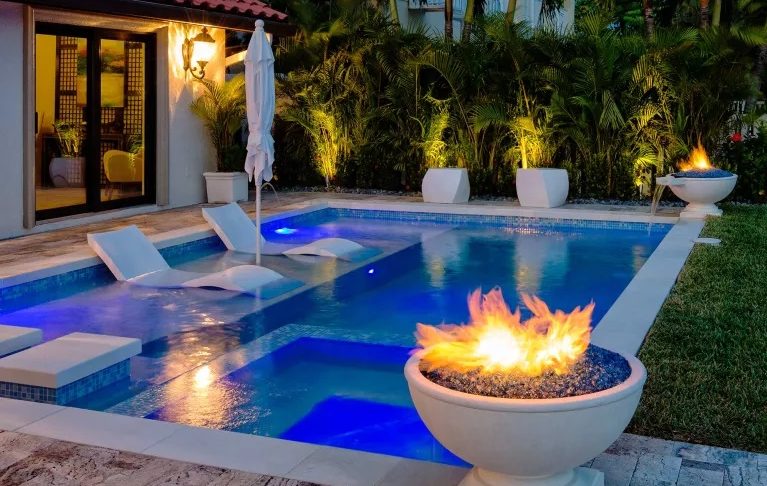
Floating solar-powered lights:
Floating solar-powered lights are a versatile, easy-to-install, and temporary solution that adds visual appeal to your pool.
These include light buoys, special lily pad lights, floating illuminated globe lights, solar-powered candles, and flamboyant flamingos.
To Sum Up
With lighting, your pool area becomes an enchanting oasis, beckoning others to share in the splendor. Beyond the sheer aesthetic delight, pool lighting can add immeasurable value to your home.
While the internet is awash with many practical tutorials, never underestimate the value of a professional pool contractor or certified electrician. Their expertise will help you determine the most suitable locations for your swimming pool lights and ensure that your selections align with safety standards.

